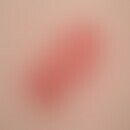DefinitionThis section has been translated automatically.
Imidazo-quinoline derivative with topical immunomodulating, antiviral, tumor-inhibiting effect. Imiquimod was developed by 3M Pharmaceuticals Saint Paul in the USA. Imiquimod was originally developed as a nucleoside analog in the search for new drugs against herpes viruses. It was first approved by the US Food and Drug Administration (FDA) in February 1997 for the topical treatment of anogenital warts in patients aged 12 years and older and later (in 2004) for superficial basal cell carcinoma (sBCC) and actinic keratoses (AK).
Pharmacodynamics (Effect)This section has been translated automatically.
Despite extensive research into the mechanism of action of imiquimod, this is still unclear due to its pleiotropic effects on a variety of diseases. Imiquimod is a synthetic toll-like receptor (TLR) agonist and thus has an "immunomodulatory" effect.
Imiquimod activates the NLRP3 inflammasome (see inflammasome below), which responds to cellular stress and tissue damage (Groß C 2016). Imiquimod activates Toll-like receptors 7 and 8 on dendritic cells, macrophages and monocytes. Stimulation of these receptors triggers a pro-inflammatory response with increased synthesis of IFN-alpha, TNF-alpha, interleukins 1, 6, 8 and 12 as well as chemokines such as CCL2, CCL3 and CCL4. Among other things, the phosphorylation of the transcription factor NF kappa B (kappa gene enhancer binding protein) and of transcription factors for interferon is stimulated.
In addition, imiquimod can enhance acquired immunity by activating plasmacytoid dendritic cells (pDCs), a unique subset of immune cells that strongly express TLR7/9 and are responsible for the production of type I IFNs, namely IFN-alpha and IFN-β. The interaction between imiquimod and TLR7 on pDCs leads to activation of the TLR7/MyD88 pathway and subsequently to robust production of type I IFNs, which are essential for the innate immune response as well as for the Th1 polarization pattern.
In addition to the TLR-dependent signaling pathway, Imiquimod has been shown to enhance inflammatory responses by interacting with adenosine receptors. Furthermore, imiquimod at high concentrations directly induces apoptosis in tumor cells in vitro and in vivo by activating the endogenous signaling pathway (Cantisani C et al. 2012).
In addition, the therapeutic effect of imiquimod is partly due to its antiangiogenic effect. The production of IFNs, IL-10 and IL-12 leads to downregulation of some proangiogenic factors, apoptosis of vascular endothelial cells and inhibition of vascular movement and invasion.
You might also be interested in
IndicationThis section has been translated automatically.
Approved for the topical treatment of condylomata acuminata (external genital warts) in the genital and perianal area in adults.
Approved for the topical treatment of actinic keratoses and small superficial basal cell carcinomas in adults. Topical treatment is a suitable alternative to surgical resection for superficial tumors, especially for multiple trunk skin basal cell carcinomas.
The pleiotropic effect of imiquimod makes it an effective treatment for many dermatologic conditions. With increasing research, imiquimod is also increasingly being used off-label for the treatment of other diseases, such as herpes simplex (Deza G et al. 2015). Clinical successes (no approval) have been reported in Bowen's disease(off-label use). Furthermore, smaller studies have described successes in mollusca contagiosa and in therapy-resistant verrucae planae juveniles. Individual observations exist on the successful treatment of lentigo maligna (off-label use) and the plaque stage of mycosis fungoides (off-label use).
Limited indicationThis section has been translated automatically.
Dosage and method of useThis section has been translated automatically.
Imiquimod is marketed in two concentrations, 5% and 3.75%, with the former being used more frequently. For the 5% Imiquimod cream (Aldara), apply a thin layer 3 times/week before going to bed and leave on the skin for 6-10 hours.
- For superficial basal cell carcinoma: apply a thin layer once a day for 5 days/week and leave on for 8-10 hours. Treatment for a total of 6 weeks. Numerous studies confirm good healing (80%). However, Imiquimod therapy is not yet covered by all statutory health insurance companies. It is advisable to apply to the insurance provider for cost coverage in advance of a planned therapy. Topical treatment is a suitable alternative to surgical resection for superficial tumors, especially for multiple trunk skin basal cell carcinomas.
- For actinic keratoses: application 3 times/week for 4 weeks on the affected areas. Further cycle if required. In an open study with 829 volunteers, a cure rate of 85.4% was reported.
- Condylomata acuminata: Apply 3 times/week for a total of 3-4 weeks.
- For the 3.75% imiquimod in cream base (Zyklara), the following application applies for actinic keratoses: 1 sachet of the cream is applied once daily in the evening to the face and/or hairless scalp. The first treatment cycle lasts 2 weeks, followed by a treatment break of 2 weeks, then a new treatment phase of 2 weeks (2 on - 2 off - 2 on). If the local skin reactions (possibly also the systemic side effects), which can usually occur at the end of the 2nd and 6th week of treatment, are unacceptable, treatment can be temporarily interrupted. Complete remission is 67% 6 months after the end of treatment.
Undesirable effectsThis section has been translated automatically.
Note! According to our own experience, headaches, flu-like symptoms (fever) and myalgia often occur despite topical application (5-10% of patients).
In addition: erythema, erosion, excoriation, scaling and edema in the application areas. Rarely induration, ulceration, scabbing and blistering. In one case, a capillary leak syndrome with fatal outcome (multi-organ failure) was attributed to the use of imiquimod. The tear resistance of condoms and vaginal pessaries may be impaired. In patients with many treated skin lesions, severe manifestations of the mentioned side effects in the sense of a stronger immune induction are known.
Recall dermatitis has been described in areas of skin treated with imiquimod and a subsequent vaccination with an mRNA COVID-19 vaccine (Roshardt Prieto NM et al. 2023)
PreparationsThis section has been translated automatically.
Aldara 5% cream; Cyclara 3,75% cream (see also http://online.rote-liste.de/suche/stoff/990617)
LiteratureThis section has been translated automatically.
- Beutner KR et al. (1999) Therapeutic response of basal cell carcinoma to the immune response modifier imiquimod 5% cream. J Am Acad Dermatol 41: 1002-1007
- Cantisani C et al. (2012) Imiquimod 5% cream use in dermatology, side effects and recent patents. Recent Pat Inflamm Allergy Drug Discov. 6:65-69.
- Cook-Bolden F, Weinberg JM (2002) Topical imiquimod 5% cream in the treatment of Bowen's disease of the penis. J Am Acad Dermatol 46: 146-147
- Deeths MJ et al. (2005) Treatment of patch and plaque stage mycosis fungoides with imiquimod 5% cream. J Am Acad Dermatol 52: 275-280
- Deza G et al. (2015) Successful treatment of hypertrophic herpes simplex genitalis in HIV-infected patient with topical imiquimod. J Dermatol 42:1176-1178.)
- Diaz-Arrastia C et al. (2001) Clinical and molecular responses in high-grade intraepithelial neoplasia treated with topical imiquimod 5%. Clin Cancer Res 7: 3031-3033
- Drehs MM et al. (2002) Successful treatment of multiple superficial basal cell carcinomas with topical imiquimod: case report and review of the literature. Dermatol Surg 28: 427-429
- Epstein E (2003) Extensive lentigo maligna clearing with topical imiquimod. Arch Dermatol 139: 944-945
- Firooz A et al. (2006) Imiquimod in combination with meglumine antimoniate for cutaneous leishmaniasis: a randomized assessor-blind controlled trial. Arch Dermatol 142: 1575-1579
- Geisse J et al. (2004) Imiquimod 5% cream for the treatment of superficial basal cell carcinoma: results from two phase III, randomized, vehicle-controlled studies. J Am Acad Dermatol 50: 722-733
- Gross CJ et al.m(2016) Efflux-Independent NLRP3 Inflammasome Activation by Small Molecules
Targeting Mitochondria. Immunity 45:761-773. - Hengge UR (2001) Topical immunomodulators--progress towards treating inflammation, infection, and cancer. Lancet Infect Dis 1: 189-198
- Hengge UR, Stark R (2001) Topical imiquimod to treat intraepidermal carcinoma. Arch Dermatol 137: 709-711
- Kagy MK, Amonette R (2000) The use of imiquimod 5% cream for the treatment of superficial basal cell carcinomas in a basal cell nevus syndrome patient. Dermatol Surg 26: 577-578
- Mackenzie-Wood A (2001) Imiquimod 5% cream in the treatment of Bowen's disease. J Am Acad Dermatol 44: 462-470
- Marks R et al. (2001) Imiquimod 5% cream in the treatment of superficial basal cell carcinoma: results of a multicenter 6-week dose-response trial. J Am Acad Dermatol. 44: 807-813
- Netzwerk aktuell (2004) Capillary leak syndrome under imiquimod (Aldara cream). Drug Telegram 35: 16
- Oster-Schmidt C (2001) Imiquimod: a new possibility for the treatment-resistant verrucae planae. Arch Dermatol 137: 666-667
- Roshardt Prieto NM et al. (2023) mRNA COVID 19 vaccine-induced recall dermatitis after topical imiquimod. J Dtsch Dermatol Ges 21:659-660.
- Smith KJ et al. (2002) Topical 5% imiquimod for the therapy of actinic cheilitis. J Am Acad Dermatol 47: 497-501
- Sterry W, Ruzicka T et al. (2002) British Journal of Dermatology 147: 1227-1236
- Stockfleth E et al. (2004) Low incidence of new actinic keratoses after topical 5% imiquimod cream treatment: a long-term follow-up study. Arch Dermatol 140: 1542
- Stockfleth E et al. (2002) A randomized, double-blind, vehicle-controlled study to assess 5% imiquimod cream for the treatment of multiple actinic keratoses. Arch Dermatol 138: 1498-1502
- Stockfleth E et al. (2001) Successful treatment of actinic keratosis with imiquimod cream 5%: a report of six cases. Br J Dermatol 144: 1050-1053
- Wigbels B (2001) Imiquimod: a new treatment possibility in bowenoid papulosis? Dermatologist 52: 128-131




